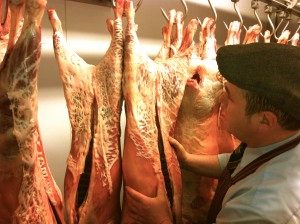
When I first came to butchery on leaving school in the early 80’s, the first Spring Lamb was a long awaited delicacy which didn’t show itself until the Easter period. Last year’s lamb had all but dried up around Christmas time, and what was left, the hogget as it would now be called, was considered a somewhat inferior product, being dark fleshed and could eat a little ‘woody’. This was often replaced by New Zealand frozen lamb, or Canterbury Lamb as it was also known, for these few bleak months.
So the arrival of spring lamb was greatly received, and still is. Spring lamb is the first crop of early born lambs. Perhaps 12-16 weeks old and still being fed on ewes’ milk. The flesh colour is pale, almost salmon pink, the texture is soft and tender with a light and delicate flavour. It is the sheep equivalent to veal or suckling pig.
Once the lambs have had a few more weeks of grass and sunshine, the characteristics change and become much more like the lamb we are used to enjoying.
Spring lamb is probably an over used name, but in my book, true milk fed spring lamb is a joy to eat, with an incredibly short season. Easter will always be the best time to appreciate this.
And the best way to cook spring lamb? Simply roast it pink, and serve with early Jersey Royal potatoes.
Now if you fancy something a little different, how about butterflying the leg and cooking it on the barbecue or just on the rack in the oven? Take a look at this video to give you some help.

